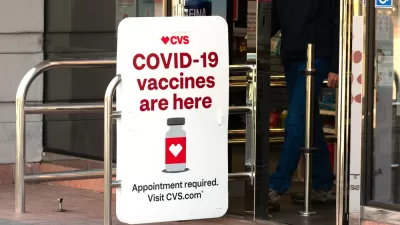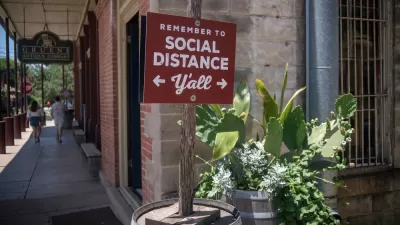The CDC announced on April 7 that a coronavirus variant first detected in the U.K is now dominant in the U.S. "In some ways, we're almost in a new pandemic," said one prominent public health expert earlier about the more transmissible variant.

"B117, the coronavirus variant first detected in the United Kingdom in December, is now the most common variant in the United States, according to Centers for Disease Control and Prevention (CDC) Director Rochelle Walensky, MD, MPH," reported Stephanie Soucheray for CIDRAP News on Wednesday, April 7.
Walensky made the announcement today during the White House press briefing [transcript + White House YouTube (27 minutes)] on the pandemic. She said the variant was behind the recent spike in cases, which has the United States seeing an average of 63,000 new cases each day.
On Saturday, over 62,000 cases were reported, according to The New York Times, resulting in a 7-day average of almost 68,000 cases, an increase of 11 percent from the average two weeks earlier.
"Dr. Rochelle Walensky..., who warned last week that she felt a recurring sense of 'impending doom,' said on Wednesday that 52 of the agency’s 64 jurisdictions — which include states, some major cities and territories — are now reporting cases of these so-called 'variants of concern,' including B.1.1.7.," wrote Sheryl Gay Stolberg and Carl Zimmer for The New York Times in their report (source article) on the White House COVID-19 Response Team press briefing.
B.1.1.7, the first variant to come to widespread attention, is about 60 percent more contagious and 67 percent more deadly than the original form of the coronavirus, according to the most recent estimates. The C.D.C. has also been tracking the spread of other variants, such as B.1.351, first found in South Africa, and P.1, which was first identified in Brazil.
While dominant, B.1.1.7 "accounts for 27 percent of all cases in this country," reported The Washington Post on April 8. The variant is far more prevalent overseas.
Vaccine breakthrough infections
According to a study on what are known as vaccine breakthrough infections posted April 9 by Tel Aviv University and Israel’s largest healthcare provider, Clalit, the B.1.1.7 variant "has come to comprise nearly all COVID-19 cases in Israel, the researchers said," reported Maayan Lubell for Reuters on April 11. The study found that the B.1.351 variant, while comprising "about 1% of all the COVID-19 cases across all the people studied," was more likely to "break through" the protection provided by the Pfizer/BioNTech’s COVID-19 vaccine than the B.1.1.7 variant.
“We found a disproportionately higher rate of the South African variant among people vaccinated with a second dose, compared to the unvaccinated group. This means that the South African variant is able, to some extent, to break through the vaccine’s protection,” said Tel Aviv University’s Adi Stern.
Lubell noted that the study was not yet peer-reviewed. Other caveats about the findings were noted in the article as well.
Nation's epicenter
The prevalence of B.1.1.7 is one of the reasons for the explosive growth in cases in Michigan, now the epicenter for the virus in the nation. Michigan, the nation's tenth most populous state, averaged 7,353 cases on April 10, almost as much as the nation's fourth-largest state, New York which averaged 7,385, according to the Times' databases for each state.
If Michigan was a nation, it would have the world's second-highest case incidence, 74 per 100,000 people, after Uruguay with 113 per 100k, but more than Sweden, the second-highest, with 61 cases per 100k, according to The Washington Post's U.S. and global coronavirus databases on April 11. The U.S. is averaging 21 cases per 100k, an increase of 4% in the past week.
Wave rather than surge?
"I believe that, in some ways, we're almost in a new pandemic," Dr. Michael Osterholm, who heads the University of Minnesota's Center for Infectious Disease Research and Policy (CIDRAP), told "Fox News Sunday" host Chris Wallace (8-minute Fox News video), as reported by Nina Golgowski for HuffPost on April 4. "The only good news is that the current vaccines are effective against this particular variant B.1.1.7."
In addition to this variant being known to be more contagious and deadly, Osterholm said it is more likely to affect children, an age group that throughout the pandemic had been largely unaffected by COVID-19.
While Osterholm called it a "fourth wave," it may have been the first time he identified the surges or peaks as waves, previously likening the pandemic in the U.S. to a forest fire that never fully burns out, as he told Chuck Todd on NBC’s “Meet the Press” last June, reported by HuffPost:
“I don’t see this slowing down through the summer or into the fall. I don’t think we’re going to see one, two and three waves. I think we’re going to just see one very, very difficult forest fire of cases.”
As noted in a post here last May, the wave metaphor was applied to the three distinct waves of the 1918 flu pandemic, with the second from September through November of 1918, being the most deadly. In the coronavirus pandemic's fourth surge, the virus has taken on a new form, dominated by the B.1.1.7 variant, as CDC Director Walensky made clear during Wednesday's briefing, which is increasingly targetting a younger demographic than the original or "wild-type" of the coronavirus that lacked mutations.
The last word go to Andy Slavitt, the White House senior advisor on the COVID-19 response, who repeated a grim but necessary warning uttered by President Joe Biden a day earlier as to why it is necessary to follow public health measures (from the transcript):
Better days are on the horizon. We do believe a more normal Fourth of July holiday is within reach. But that’s nearly three months away. And as the President said [on April 6, marking the 150 millionth COVID-19 vaccine shot], “The real question is: How much death, disease, and misery are we going to see between now and then?”
So, before I turn to Dr. Walensky, let me just close by reminding Americans: It is in our power to minimize death, disease, and misery. If we — if all of us do our part, we can help save lives in April, May, and June.
Wear a mask. Socially distance. Get vaccinated when it’s your turn.
Related in Planetizen:
- Pandemic Geography: What's Going on in Michigan? April 4, 2021
-
CDC Director Expresses a Feeling of 'Impending Doom', March 30, 2021
-
Experts: Fourth Coronavirus Surge Likely More of a Ripple, March 11, 2021
-
A Fourth Coronavirus Surge is Likely, March 1, 2021
-
Second Wave or Second Peak? May 27, 2020
-
Awaiting the Mutant Storm(s), February 4, 2021
FULL STORY: More Contagious Virus Variant Is Now Dominant in U.S., C.D.C. Chief Says

Alabama: Trump Terminates Settlements for Black Communities Harmed By Raw Sewage
Trump deemed the landmark civil rights agreement “illegal DEI and environmental justice policy.”

Study: Maui’s Plan to Convert Vacation Rentals to Long-Term Housing Could Cause Nearly $1 Billion Economic Loss
The plan would reduce visitor accommodation by 25% resulting in 1,900 jobs lost.

Planetizen Federal Action Tracker
A weekly monitor of how Trump’s orders and actions are impacting planners and planning in America.

Grand Rapids Mayor Proposes Garage Conversion Plan
The mayor says allowing homeowners to convert garages to dwelling units could alleviate the city’s housing shortage.

Baltimore Ordered to Improve Sidewalk Accessibility
The city is one of many to face lawsuits for failing to comply with the Americans with Disabilities Act.

This Toronto Suburb Has More Bus Riders Than Columbus, Ohio
Brampton, Ontario used gradual improvements in service to prove that if you build it, they will ride.
Urban Design for Planners 1: Software Tools
This six-course series explores essential urban design concepts using open source software and equips planners with the tools they need to participate fully in the urban design process.
Planning for Universal Design
Learn the tools for implementing Universal Design in planning regulations.
Smith Gee Studio
Alamo Area Metropolitan Planning Organization
City of Santa Clarita
Institute for Housing and Urban Development Studies (IHS)
City of Grandview
Harvard GSD Executive Education
Toledo-Lucas County Plan Commissions
Salt Lake City
NYU Wagner Graduate School of Public Service





























